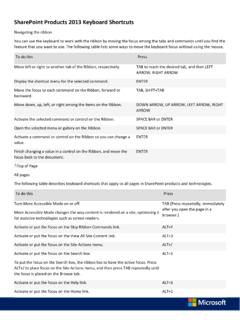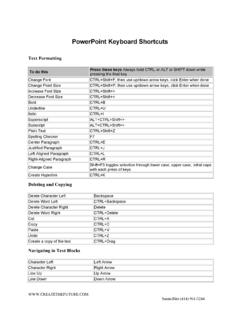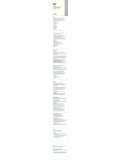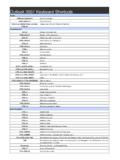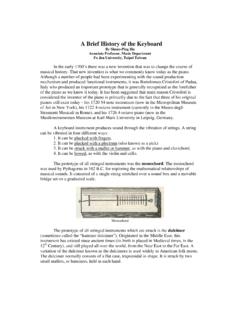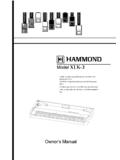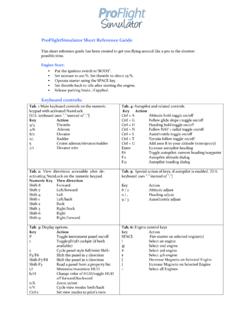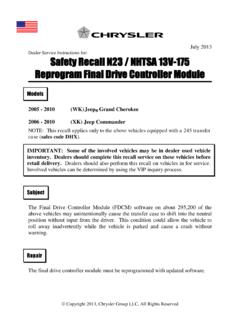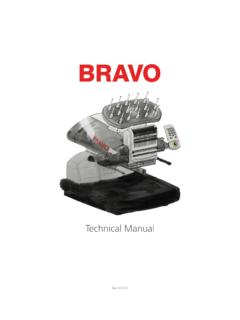Transcription of Outlook 2013 Keyboard Shortcuts - Eric Ligman
1 Outlook 2013 Keyboard Shortcuts Basic navigation To do this Press Switch to Mail. Ctrl+1 Switch to Calendar. Ctrl+2 Switch to Contacts. Ctrl+3 Switch to Tasks. Ctrl+4 Switch to Notes. Ctrl+5 Switch to Folder List in Folder Pane. Ctrl+6 Switch to Shortcuts . Ctrl+7 Switch to next message (with message open). Ctrl+Period Switch to previous message (with message open). Ctrl+Comma Move between the Folder Pane, the main Outlook window, the Reading Pane, and the To-Do Bar. Ctrl+Shift+Tab or Shift+Tab Move between the Outlook window, the smaller panes in the Folder Pane, the Reading Pane, and the sections in the To-Do Bar. Tab Move between the Outlook window, the smaller panes in the Folder Pane, the Reading Pane, and the sections in the To-Do Bar, and show the access keys in the Outlook ribbon.
2 F6 Move around message header lines in the Folder Pane or an open message. Ctrl+Tab Move around within the Folder Pane. Arrow keys Go to a different folder. Ctrl+Y Go to the Search box. F3 or Ctrl+E In the Reading Pane, go to the previous message. Alt+Up Arrow or Ctrl+Comma or Alt+Page Up In the Reading Pane, page down through text. Spacebar In the Reading Pane, page up through text. Shift+Spacebar Collapse or expand a group in the email message list. Left Arrow or Right Arrow, respectively Go back to previous view in main Outlook window. Alt+B or Alt+Left Arrow Go forward to next view in main Outlook window. Alt+Right Arrow Select the InfoBar and, if available, show the menu of commands.
3 Ctrl+Shift+W Search To do this Press Find a message or other item. Ctrl+E Clear the search results. Esc Expand the search to include All Mail Items, All Calendar Items, or All Contact Items, depending on the module you are in. Ctrl+Alt+A Use Advanced Find. Ctrl+Shift+F Create a Search Folder. Ctrl+Shift+P Search for text within an open item. F4 Find and replace text, symbols, or some formatting commands. Works in the Reading Pane on an open item. Ctrl+H Expand search to include items from the current folder. Ctrl+Alt+K Expand search to include subfolders. Ctrl+Alt+Z Flags To do this Press Open the Flag for Follow Up dialog box to assign a flag.
4 Ctrl+Shift+G Color Categories To do this Press Delete the selected category from the list in the Color Categories dialog box. Alt+D Create an item or file To do this Press Create an appointment. Ctrl+Shift+A Create a contact. Ctrl+Shift+C Create a contact group. Ctrl+Shift+L Create a fax. Ctrl+Shift+X Create a folder. Ctrl+Shift+E Create a meeting request. Ctrl+Shift+Q Create a message. Ctrl+Shift+M Create a note. Ctrl+Shift+N Create a Microsoft Office document. Ctrl+Shift+H Post to this folder. Ctrl+Shift+S Post a reply in this folder. Ctrl+T Create a Search Folder. Ctrl+Shift+P Create a task. Ctrl+Shift+K Create a task request.
5 Ctrl+Shift+U Command commands in most items To do this Press Save (except in Tasks). Ctrl+S or Shift+F12 Save and close (except in Mail). Alt+S Save as (only in Mail). F12 Undo. Ctrl+Z or Alt+Backspace Delete an item. Ctrl+D Print. Ctrl+P Copy an item. Ctrl+Shift+Y Move an item. Ctrl+Shift+V Check names. Ctrl+K Check spelling. F7 Flag for follow-up. Ctrl+Shift+G Forward. Ctrl+F Send or post or invite all. Alt+S Enable editing in a field (except in Mail or Icon view). F2 Left align text. Ctrl+L Center text. Ctrl+E Right align text. Ctrl+R Mail To do this Press Switch to Inbox. Ctrl+Shift+I Switch to Outbox. Ctrl+Shift+O Choose the account from which to send a message.
6 Ctrl+Tab (with focus on the To box), and then Tab to the Accounts button Check names. Ctrl+K Send. Alt+S Reply to a message. Ctrl+R Reply all to a message. Ctrl+Shift+R Reply with meeting request. Ctrl+Alt+R Forward a message. Ctrl+F Mark a message as not junk. Ctrl+ Alt+J Display blocked external content (in a message). Ctrl+Shift+I Post to a folder. Ctrl+ Shift+S Apply Normal style. Ctrl+Shift+N Check for new messages. Ctrl+M or F9 Go to the previous message. Up Arrow Go to the next message. Down Arrow Create a message (when in Mail). Ctrl+N Create a message (from any Outlook view). Ctrl+Shift+M Open a received message.
7 Ctrl+O Delete and Ignore a Conversation. Ctrl+Shift+D Open the Address Book. Ctrl+Shift+B Add a Quick Flag to an unopened message. Insert Display the Flag for Follow Up dialog box. Ctrl+Shift+G Mark as read. Ctrl+Q Mark as unread. Ctrl+U Open the Mail Tip in the selected message. Ctrl+Shift+W Find or replace. F4 Find next. Shift+F4 Send. Ctrl+Enter Print. Ctrl+P Forward. Ctrl+F Forward as attachment. Ctrl+Alt+F Show the properties for the selected item. Alt+Enter Create a multimedia message Ctrl+Shift+U Mark for Download. Ctrl+Alt+M Clear Mark for Download. Ctrl+Alt+U Display Send/Receive progress. Ctrl+B (when a Send/Receive is in progress) Calendar To do this Press Create an appointment (when in Calendar).
8 Ctrl+N Create an appointment (in any Outlook view). Ctrl+Shift+A Create a meeting request. Ctrl+Shift+Q Forward an appointment or meeting. Ctrl+F Reply to a meeting request with a message. Ctrl+R Reply All to a meeting request with a message. Ctrl+Shift+R Show 1 day in the calendar. Alt+1 Show 2 days in the calendar. Alt+2 Show 3 days in the calendar. Alt+3 Show 4 days in the calendar. Alt+4 Show 5 days in the calendar. Alt+5 Show 6 days in the calendar. Alt+6 Show 7 days in the calendar. Alt+7 Show 8 days in the calendar. Alt+8 Show 9 days in the calendar. Alt+9 Show 10 days in the calendar. Alt+0 Go to a date. Ctrl+G Switch to Month view.
9 Alt+= or Ctrl+Alt+4 Go to the next day. Ctrl+Right Arrow Go to the next week. Alt+Down Arrow Go to the next month. Alt+Page Down Go to the previous day. Ctrl+Left Arrow Go to the previous week. Alt+Up Arrow Go to the previous month. Alt+Page Up Go to the start of the week. Alt+Home Go to the end of the week. Alt+End Switch to Full Week view. Alt+Minus Sign or Ctrl+Alt+3 Switch to Work Week view. Ctrl+Alt+2 Go to previous appointment. Ctrl+Comma or Ctrl+Shift+Comma Go to next appointment. Ctrl+Period or Ctrl+Shift+Period Set up recurrence for an open appointment or meeting. Ctrl+G See also under Views, Calendar Day/Week/Month view, and Date Navigator.
10 People To do this Press Dial a new call. Ctrl+Shift+D Find a contact or other item (Search). F3 or Ctrl+E Enter a name in the Search Address Books box. F11 In Table or List view of contacts, go to first contact that starts with a specific letter. Shift+letter Select all contacts. Ctrl+A Create a message with selected contact as subject. Ctrl+F Create a contact (when in Contacts). Ctrl+N Create a contact (from any Outlook view). Ctrl+Shift+C Open a contact form for the selected contact. Ctrl+O Create a contact group. Ctrl+Shift+L Print. Ctrl+P Update a list of contact group members. F5 Go to a different folder. Ctrl+Y Open the Address Book.


